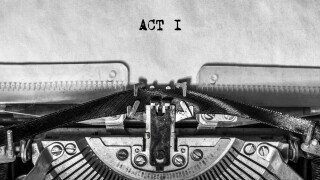Why All Movies And Shows Follow A Three-Act Structure

Welcome to Cracked's Secret Rules Of Movies, where, in an ice cream truck with no license plates, we harvest the kidneys of the modern Hollywood narrative. Today's topic: the three-act structure.
Yesterday I told you about the Hero’s Journey, and my goal here is to peel away things that are increasingly essential to film layer by layer, column by column, and try to figure out what’s at the core of Movies (current scholarship believes this is “das Kinogeist,” the tortured ghost of a German mechanist who died attempting to eat an entire magic lantern on a dare).
Don't Miss
Today we’ll be tackling something related to the Hero’s Journey but even more ubiquitous: the three-act structure.
What’s the Rule?
I say three-act structure is “related” because the Hero’s Journey is itself broken up into three parts. There’s lots of different nomenclature used, but the three acts are the Setup (“I want a hotdog, but the Mayor has made them illegal”), the Confrontation (“I will challenge the Mayor to gladiatorial combat to make hotdogs legal again”), and the Resolution (“I have triumphed, but in doing so have learned that a tube of sub-dogfood quality hog anuses may have been what I wanted, but it wasn’t what I needed”). Beginning, Middle, and End.

Puikstekend/Wikimedia Commons
Three-act structure is super basic stuff. This may surprise you based on how often I write things like “my pubic hair is so thick my penis looks like a gorilla giving a thumbs-up through a bird’s nest,” but I actually used to be a educator. A big part of what I did was teaching elementary-school-aged kids the basis of storycraft, and my introductory lesson was a simplified version of the three-act structure. That’s how I learned how fundamental it is: it’s literally one of the first things we teach to children about storytelling. Incidentally, that’s also how I learned it’s difficult to share your love of storycraft when your audience is a pack of semi-feral children, one of whom appears to be convinced she will die if she doesn’t swallow every Hot Wheel in the room. Instead I now write for the Internet, an audience who will only swallow one Hot Wheels at most.
The origin of the three-act structure is a matter of some debate. It’s commonly attributed to screenwriting guru Syd Field’s 1979 book Screenplay: The Foundations of Screenwriting, but that’s obviously BS because Joseph Campbell identified a recurring three-act structure across ancient myths in 1949. Some people also cite Aristotle as the originator of the three-act structure, except this is also BS because Aristotle supported a two-act structure (Tangling and Untangling). So where did the three-act come from? Why does it have such staying power? Will it still be relevant in the future of a rapidly changing market?
No one knows. Article over. Flip over to the next tab I know you have open and finish that search for Shrek Tells You He’s Proud of You (ASMR).
But Why, Though?
Ah, you’re still here. Good. Passed The Test have thee, so secret knowledge your reward shall be! Oh, damn, I’m fresh out of Secret Knowledge, so you’ll have to settle for some assumptions, logical conclusions, and wild speculation.
I think film largely breaks into the three-act structure partially because it naturally delivers a satisfying, compelling rhythm and partially because mainstream Hollywood filmmaking is a system that is deeply risk averse and over time the three-act structure has de facto become part of filmic orthodoxy, like heroes not looking at explosions or Sam Rockwell ad libbing in a little dancing scene.
But there’s a much more practical reason why it exists in television: commercials! The reason the show exists in the first place! To sell the dumb slobs at home a luxury earhole degreaser or Attacked By Birds Insurance or a service that charges $1,000 a month to mail you groceries that are mostly expired Spyro jellybeans from the Gamestop check-out line. The three-act structure lends itself to TV because it leads to natural breaks in the story where commercials can be stuffed in. In fact, particularly for network TV, scripts are commonly written with act breaks literally written into the script itself. It’s probably worth noting here that hourlong dramas are sometimes written to a five-act structure. I know there are exceptions. You do not get a prize for naming them.

Tatiana Chekrzhova/Shutterstock
Okay, But What if You Didn’t?
Well, to start, I’d like to quote David Fincher: “Okay, but can we make the shot more green?”
Wait, sorry, wrong quote! I meant this one: “I think that if we can make a playground for {people who are sick of Marvel movies} that is thoughtful, adult, interesting, complex, challenging stories and figure out ways to pull them into it, there’s a chance at something that isn’t lassoed and hogtied by three acts.” Lassoed and hogtied by three acts – leave it to David Fincher to turn even film criticism into an exploration of the psychosexual. Weirdly fetishistic phraseology aside, Fincher raises a great point. He, like many filmmakers, has begun to feel hampered by the three-act structure – which is probably why The Girl With the Dragon Tattoo follows a somewhat unconventional FIVE-act structure. Fincher isn’t alone in hoping that the rigidity of the Syd Fieldian paradigm is something that we can transcend – I myself almost never write to a specific act structure. I am also not a professional screenwriter. There may be a correlation there.
This is probably a case where the revolution will, in fact, be televised: despite originally having a much more vested interest in preserving the three-act structure and, in particular, utilizing act breaks, it seems to me that TV is the frontier where we’re going to see the three-act structure have its stranglehold broken. It’s also, if God is merciful, the frontier where we’ll finally see greater acceptance of male nudity. If we want another Golden Age of Television, hangin’ schmeat is the way to usher in the new halcyon days.

Antonio Guillem/Shutterstock
You might be surprised to hear that TV is where I think the three-act structure is going to become less ubiquitous. Or maybe you aren’t if you’re under the age of forty and, like me, haven’t seen an actual commercial since people were crankin’ that Soulja Boy.
It's because streaming has completely changed the way we consume television. The subscription model seems to be becoming the standard, and while it’s unclear how sustainable it is, commercial breaks – like laugh tracks and Very Special Episodes about the dangers of doing even just one marijuana – just aren’t as crucial to TV as they once were. I’ve read hundreds of pilot scripts, and I think the best one is Matthew Weiner’s Mad Men – Smoke Gets in Your Eyes. Although AMC eventually picked up the show, Weiner originally wanted it to air on HBO, which doesn’t have commercials – and so, he wrote the script without act breaks. While Mad Men does have act structure, I think the fact that it was written for a subscription network but aired on cable was the beginning of a change in the industry that we’re still undergoing. I’d also hoped that it would usher in a new golden age of pencil skirts, but alas, if this were a just world it would be illegal to make a movie that didn’t have Christina Hendricks in it.
The other big component here is something I’ve written about before: the way we understand movies is changing with streaming. What we consider a “movie” is largely defined by the constraints of seeing it somewhere other than your own house on your own couch with your own ass-impressions deep in the cushions. But people don’t watch movies in theaters as much as they do at home anymore. Which in turn means that the line between film and TV will begin to blur, as will the accepted norms of what makes a movie a movie and not a series. If the Silmarillion movie ends up being seven hours long to accommodate all of the musical numbers, fart jokes, and gratuitous elf orgies, will it really matter if it’s streaming only? You’ll have the ability to pause it when you want and come back to it when you please. Is a seven-hour movie really that different from the most recent season of Stranger Things?
What this means for the future of the three-act structure I’m honestly not sure. But I’m sure if you asked David Fincher, he’d tell you the influence of streaming will take the three-act structure, whip it until it calls you mommy, squeeze it into a latex suit, and tell it it’s been a naughty, naughty little boy.
William Kuechenberg is a repped screenwriter, a Nicholl Top 50 Finalist, and an award-winning filmmaker. He’s currently looking to be a writer’s assistant or showrunner’s assistant on a television show: tell your friends, and if you don’t have any friends, tell your enemies! You can also view his mind-diarrhea on Twitter.
Top image: GAS-Photo/Shutterstock